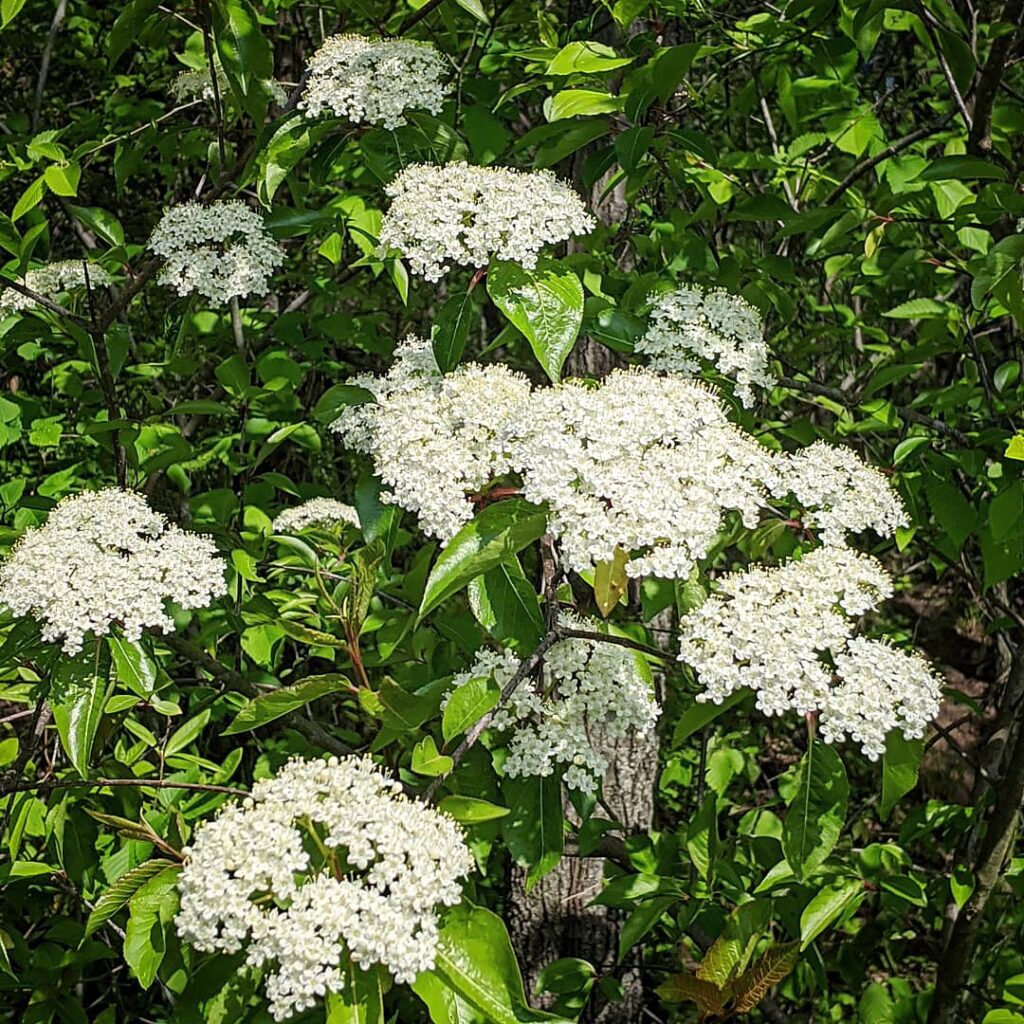Plant Profiles: Thicket Forming Shrubs
-Henry “Weeds” Eilers
When we think about our woodlands – what comes to mind? Perhaps the earliest wildflowers after a long cold winter or hunting for morels a bit later. And then there are large trees of course, such as oaks and hickories.
We think less often of the understory, unless such iconic species as dogwood and redbud are in bloom. They are part of some 30 such species that make their home at the Shoal Creek Conservation Area. There are ground hugging species, such as New Jersey tea, Carolina rose and lead plant that barely qualify as woody plants, and others that on occasion can rival the usual canopy trees in size. A bit of research, for instance, showed that the ubiquitous sassafras can grow to enormous sizes. Larry Mahan in his ‘In Search of Large Trees’ lists two champions with over 16’ and 18’ circumference, with the first one in our neighboring Macoupin County. Guy Sternberg in his ‘Native Trees for North American Landscapes’ mentions even larger trees.

Recovery is slow, but the land is healing as ever more forbs, grasses and sedges recruit in the ground layer. Surprisingly many of the species here have strong affinity to prairies. How did they survive in the ever-increasing shade? Exploring that may be for another column. Shade tolerant woodland graminoids, especially sedges, had an edge in survival as the woodlands got ever darker. But they too did not really thrive. They are returning to their former dominance where the canopy has been opened up and burns are reducing the smothering duff. While not so deep rooted, many species are symbiotic with ectomycorrhizal and arbuscular fungi. No doubt, much carbon is stored by these vastly underappreciated plants and their associated fungi and microbes as they replace much of their shallow but dense root systems annually. What do we really know about their role in the scheme of things? Perhaps not as much as what we think.
Apparently, sassafras foliage was not palatable to farm animals. That would have given this species a distinct competitive advantage over the many decades as most other species were browsed to the ground. It could well be the reason why it remains so dominant to this day. How common might it have been on the original landscape? It is an open question, I believe.
Quite abundant, especially so in long abandoned fields until recently, was smooth sumac (Rhus glabra). It apparently took a huge hit in the 2012 drought and nearly disappeared. The dead old and pithy stems are still a reminder after over 10 years. It is starting to make a comeback, with the very first new stems in flower and fruit seen last year. Quite common today by comparison is the shining sumac (Rhus copallina). I would find only a few clones in past decades. What accounts for its apparently enormous increase? Perhaps more drought resistant, it also benefitted by opening up the tree canopy by eliminating literally thousands of sugar maple in its favored upland habitat. Like most clonal species it also clearly is benefiting from decades of fire management.
Even after traipsing the woods for over 30 years I am surprised by coming across shrubs like black-haw, hazelnut, Iowa crab and American plum in unexpected places. Sometimes there are just a few sprigs and occasionally there are sizable expanses of tiny stems in the forb layer. It is in the fall when their color gives them away. How long have they been there? Recruitment from seed is most unlikely as fruit-bearing plants are absent and have been for a long time, no doubt. These are survivors from long ago—very long ago. One has to wonder what these woodlands looked like centuries ago. Henry Schoolcraft, early botanist and explorer, went by coach-and-four from St Louis to St. Genevieve through then wide-open woods in the early 1800’s. Surely our woods were that open as well. The tiny shrublets encountered today just beg us to thin the canopy and give them back their life.

Black-haw (Viburnum prunifolium) has been a part of my shrub border for decades. I have used it in my landscaping career. On two occasions I got some blowback. It is apparently very malodorous, probably at bloom time. I forgot and should still check this out! There is a bit of suckering, but not an issue where it is in my garden. A healthy stand makes a thicket that definitely invites a detour. Only once did I encounter a colony of good size and in bloom at our preserve. While very abundant, it is still far too shade suppressed in most places. Dr. Doug Tallamy spoke about it at one of his presentations at Lewis & Clark Community College in Edwardsville and contrasted its value as food for migratory birds with invasive species. Yes, we need to emphasize the use of native species for all sorts of reasons.

Another food-producing thicket plant is American plum (Prunus americana). I have yet to harvest any fruit as wildlife beats me to them every time. It is relatively fast growing but also short lived. We have it also at the Route 66 Prairie where it forms a very large patch. Here, close to the old Route 66 alignment it survived nearly 100 years of roadside maintenance. That is amazing. I will refrain from listing its many attributes other than to say that it was home here last year to 3 bird nests. No idea as to bird species as I found them only as I was admiring the gorgeous fall color. We have taken great pains to protect this clone from our restorations burns. A surprise just this year was the discovery of another plum patch at the prairie. It was a different species, Chickasaw plum (Prunus angustifolia). How did we miss it during all these 12 years of management? It also occurred at the preserve but has been absent since that awful 2012 drought.
Sassafras (Sassafras albidum) is rarely a large tree in our local woodlands. It remains a dominant woody understory component at the Shoal Creek Conservation Area, even after over 30 years of management activities. Some of the larger trees, maybe 12” in diameter, are parts of former fence rows with barbed wire and hog wire remnants still attached. They were live fence posts, cheap too, when subsistence farmers ran their herds of hogs on the narrow ridge tops and adjacent woodland slopes. Such was the case for a very long time, all over Illinois, until industrial confinement production took over only a few decades ago. Cattle and sheep utilized such marginal lands as well, even during long droughts. This land had been worked hard for over 150 years. The gullied slopes below the old fields remain as a silent testimony to land abuse to this day. That is what we call it, but I well recall that even in the 1960’s farmers reasoned differently. Soil loss was good here, as it carried disease laden animal waste away. Remember that it was before the widespread use of antibiotics when swine diseases often decimated whole herds. Another feature, though now fortunately much diminished, is stream entrenchment, all the way down to bedrock. We still see downcutting where we cannot control excessive field and roadside runoff events. Much of the loessal topsoil is long gone and only the leached hardpan and the Illinoian glacial till remains. You might say that we have, at least until fairly recently, treated our soils like, well, dirt!

Elsewhere at this prairie is an Iowa crab colony of considerable size that also survived the same roadside management conditions. Even with the use of tree tubes the growth of the crab trees has been much slower than that of the Plums. However, even 3’ trees already display an abundance of glowing pink blooms in spring. There will come a time when you will want to make a detour here. As with the plums, the thorny spurs on stout branches will rip you apart. Even now it already makes good bird and wildlife cover. This colony receives fire protection as well. Both plum and crab occur in large sizes at Shoal Creek in our old fields.

Another thicket forming shrub that is shared by both sites is rough dogwood (Cornus drummondi, now being renamed Swida drummondii). I consider it the ‘Rodney Dangerfield’ of such shrubs as it gets little respect. As a matter of fact, up north it has been loathed by prairie restorationists for as long as I can remember. It has been a part of my shrub border for over 50 years. While not spectacular from a horticultural point is has never become a nuisance; just a dependable screen plant and certainly of much benefit for nesting and feeding birds and a host of invertebrates. It beats a Forsythia any day!

One of the less common thicket plants locally is prairie willow (Salix humilis). Locally I know it only from Roberts Cemetery and Shoal Creek. Its mini catkins are a delight in late winter. Enough said. Read up on it in the cited references.

Thirty years ago small stands of hazelnut (Corylus americana) were seen mostly around the edges of the various old fields. None ever fruited. With greatly increased light availability, these colonies today are often large and vigorous. Deer browse them severely. The few shoots that escape their predation can flower in just a few short years. Elsewhere we have seen a slow but steady increase in populations. Even last fall I came across a new stand in a deer-frequented area. The large leaves aglow in fall color gave it away. In one of my garden’s shrub borders a large clump of hazelnut has spread very little over the decades. Every fall it delights with its wonderful warm fall colors. There is profuse nut production. Squirrels gorge on the unripe fruit every fall, leaving few to ripen. Even here, deer do more than the needed trimming for me. Grrr, nothing is perfect. Hazelnut forms large thickets in nearby Roberts Cemetery Savanna Nature Preserve and usually fruits prolifically here in full sun. Apparently, it has been considered so aggressive here that numerous attempts have been made to ‘control’ it with herbicides. Other control methods, especially more frequent and much hotter burns, would be preferrable. Unfortunately, this being Illinois, the nature preserves commission is woefully underfunded and understaffed. New thinking is needed. The recently formed ‘Friends of Illinois Nature Preserves’ is such a step in the right direction. Perhaps we also need to tread carefully about ever more institutionalizing and concentrating fire management. Local entities need to be empowered and trained to do the fire on the ground. It would be the only way to maximize small fall burns during mostly brief one day windows or less! There is already precedence for that and it just needs to be ramped up. As I have said before, woodland recovery by thinning and burning should be a priority from coast to coast. Think carbon storage!
Two more thoughts. The above species are clearly shared by woodlands and also prairie. One lesson I take away from this is that we need a far more open woodland structure than what we have now. We also need to be less obsessed about certain woody species on the prairie. That is a tough balance to strike today when we are dealing with such tiny and vulnerable habitat scraps.
Lastly, I would like to call attention to good information on most of the above species for home gardening, conservation plantings and more. The very best that I know of is the book: ‘Native Trees for North American Landscapes’, by Guy Sternberg. It is thorough, never boring, even humorous on occasion. You can curl up with it on cold winter evenings and will find it even engrossing if you have the slightest interest in this country’s wonderful tree flora!
